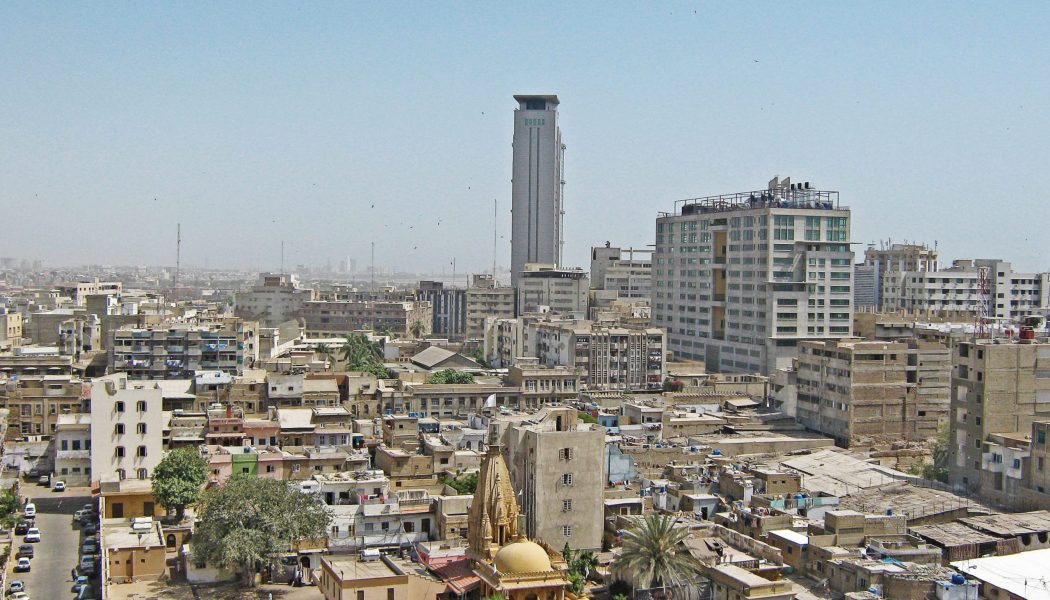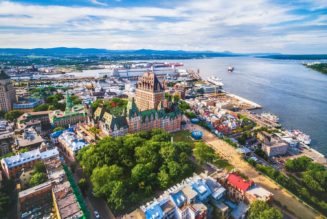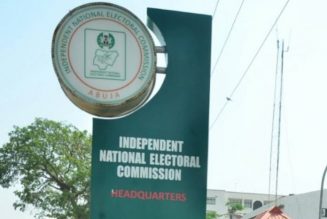The dismantling of Karachi’s markets and informal shops isn’t just robbing the city of its soul. It threatens the survival of the very people that make it a city.
A group of women in faded patterned saris sits by the side of a road, some shaded by umbrellas, with bags of dried nuts in front of them—almonds, pistachios, cashews. The image would rack up a lot of Instagram likes, if it weren’t for the devastating landscape—mounds of sand, steamrolled expanses, clouds of dust, debris, and the stark sight of a building smack in the middle. Or that these women aren’t sitting on a pavement, protected and secure in their work. They’re on the side of the road, an easy target for harassment, being pushed out from the only place they’ve ever worked, where their fathers worked, and where their children won’t end up, because Karachi’s rulers turn against the very people that make it a city.
While Karachi was once marked by seemingly unending urban conflict, the issues it now faces—gentrification, development, and control of land—threaten the lives of its residents and the city’s future.
Karachi is, perhaps, one of the greatest cities in the world. It is home to—if you believe the census—14 million people. (Or 20 million if you don’t.) It is the most populous and the most ethnically diverse city in Pakistan. It is defined by raw, unplanned development, chaos, and infrastructure that has teetered on the edge of total collapse for years, but also vibrant subcultures of music and style. It has been home to refugees passing through Karachi on their way to somewhere else, and it is home to refugees who made it into a city—one of such extreme absurdities that stories of crocodiles escaping from someone’s house or a fake immigration agency office doubling as a torture cell aren’t worth more than a few days in the news cycle.

Karachi’s informal structures are what has kept the city going—providing everything from water to housing and education. According to the noted urban planner and architect Arif Hasan, Karachi’s informal economy counts for 30 to 40 percent of its total economy. But for the last year, Karachi has quickly been stripped of its character. An “anti-encroachment” drive in the city led to the dismantling of markets and shops. The most significant of these was the Empress Market, which housed bazaars selling every item imaginable.
Empress Market served as a meeting point, a transit hub and a source of employment for tens of thousands of people. Hundreds of vendors worked in thousands of shops and stalls and pushcarts—at least 1,700 of which were demolished during the anti-encroachment drive. The market is based on the colonial-era building at its center, but what made it a market were the adjoining lanes and stalls, where there were dozens of markets clustered by type: meat, dry fruit, spices, betel nut, domestic animals. A dozen of these markets were destroyed.



The vendors had been there for decades, paying utilities and rent to the Karachi Municipal Corporation, the city’s governing body. However, in October 2018, Pakistan’s Supreme Court ordered the removal of encroachments while hearing a case about encroachments and land use in Karachi. The term encroachment is itself a source of confusion. Mohammad Toheed, a senior researcher with the Karachi Urban Lab at the Institute of Business Administration, says the city government often confuses ‘tenant’ with ‘encroacher,’ mooting the idea that encroachers had carved out a space along with lawful tenants. The city’s government interpreted the court’s order broadly, and began to tear down shops that it believed were illegal. (Many shopkeepers dispute that they were there illegally).
Encroachments—particularly on state-owned land—have long been a source of contention for the Supreme Court. In a 2011 ruling, the court called “land grabbers” and encroachers one of Karachi’s biggest problems. But action against those who misuse land is often largely directed at the poor, who are powerless in front of bulldozers and who are only left to bewail how Karachi’s heart was ripped out in front of them.
***
By the time I arrived in Karachi this spring, Empress Market was a ruin. Gone were the scorpion sellers, the bags of spices, the sidestepping around people offering to carry your groceries. Instead, my feet sank into the piles of sand as I made my way to a building that now looks more like an incongruous eyesore than anything else. Rumors had begun to spread: The city government wanted to build a park. The British—whose crown jewel this once was—were allegedly funding it. The thought of the British government coming to reclaim an old building in a former colony may seem laughable, but it is perhaps because the dismantling seemed to be so incomprehensible, so beyond the scale of normal, that conspiracy theories filled the gap.
The authorities, shopkeepers say, came at night. There was law enforcement on the site. There were only a few hours to scramble around. There was little anyone could do: stores spilled out, people tried to rent vehicles to get the goods to safety. In times of crisis, some Karachiites band together, and others seize on an opportunity. Several shop owners say there was looting. People must have grabbed what they could, when they could, in the frenzy of impending demolition. Over the course of at least two days, 1,000 shops were pulled down, including the markets for birds and used clothes.

Ultimately, everything was crushed: shops, goods—and friendships. “We’ve all dispersed,” said one former restaurateur. “The people working with us are all jobless now. Some of them are unwell. Our entire family was here—almost 15-16 households. Now someone is in Islamabad, someone is somewhere else. There is no employment.”
For its part, the city government has said that it is seeking to restore Empress Market to its original state—from over a hundred years ago. The government is also working on a ‘Karachi Neighborhood Improvement Project’, supported in part by the World Bank, which seeks to “enhance public spaces” in Karachi, including in Saddar. Empress Market seems like it will become an attraction for a showpiece downtown district. So far, there have been press reports of a museum and an art gallery to be built on the premises. The Karachi mayor, Waseem Akhtar, seemed to have summed up what “progress” looks like, telling the New York Times: “Spices and lentils, parrots and pigeons—that isn’t heritage,” he said. “We need to have something to show for our next generation. I think we’re moving toward progress.”
One man’s progress is another’s march towards gentrification.
“The mayor is playing this game with us—a game that even a tyrant wouldn’t play with the oppressed, that Israel wouldn’t do to Palestine,” said Muhammad Qasim, the head of the Empress Market traders association. Qasim’s words may seem like hyperbole, unless you see the ravaged space and hear how many people, who had been tenants for decades, were turned out onto the street.
Where would we go? This is where our earning comes from, how we earn for our children. All of our customers are here.
Months after the demolitions, the mood inside the Empress Market building is grim. A vegetable vendor is bitterly angry at being cheated out of his shop years ago. The customers aren’t laden with large bags anymore. There isn’t much to buy there that one can’t find elsewhere in the city. A rat roamed around near the butchers.
Lado has managed to stay put at Empress Market, along with a group of women, still in their faded saris and their displays of nuts. She was the only woman who agreed to speak with me. Another woman to whom some in the group steered me seemed wary, and said she would speak if I could compensate her for the time she would lose talking to me when she could be making a sale. But perhaps it is also that these women are tired of speaking up. They spoke at the press club and made a speech at the Women’s Day march, and they are still sitting by the side of the road, uncertain about their future.
Lado has worked around Empress Market for 25 years. She looks young. She doesn’t know her age, but she’s married and has three children. Lado’s father worked there before her and she took over from him. “We’ve always been on the footpath,” she said. “The police keep trying to chase us off, and there was a lot of strictness before and we couldn’t sit here. We would set up when their morning shift was over. Where would we go? This is where our earning comes from, how we earn for our children. All of our customers are here. People should think about us, about us poor women.”
Some of the displaced vendors have tried to base themselves out of other places, such as a plaza called—the despondent-sounding—Empress Mall. Some say there are plans to move them to another area of Karachi altogether. Some moved into shops across the street from Empress Market and are trying to make another go of it, putting up posters near the market building declaring that they were still around, still open for business.
One of them is Syed Safir, who is running the scissors shop his father had opened in Empress Market 40 years ago, and Mohammad, whose family had run a restaurant for 52 years. They served tea and parathas and had a staff of about 30 people. But once the restaurant was pulled down, it was hard to start again: they couldn’t find an appropriate location. He is now running a store that sells groceries, detergent, and other basic household items. There were also no customers in his shop. Safir said his father was very worried. “Obviously when people lose their business they get into a state of tension, but we have faith in Allah.”
After about 20 minutes, he said: “Have you seen a customer as yet?” No one had come in. No one did for the next hour.

There are very few things—or people—in Karachi that are indispensable. But Empress Market was a vital cog in the food supply chain of restaurants and vendors and households. It supported an economy in and of itself: the vegetable vendor hawking fresh pineapple and basil; the nut vendor, and then the person who would crush the nuts and extract oils; the boys who would carry your purchases in large jute bags; the pushcart vendor who would sell you, at the end of your long shopping trip, a glass of cold Pakola.
One of the hundreds of people who fed off the ecosystem was Siraj Ahmed. Ahmed was young when he started working—so young, he said, that his height came up to only to the cart he now pushes. Ahmed had no other choice. “It was me in the house and my father. And praise God”—he says with a tinge of sarcasm—“we had a big family. So I had to earn.” Ahmed sold slices of coconut on buses. Coconut-slice vendors spend their day in traffic, jumping in and out of buses, with a tray of coconut slices. They weave between parked buses, passing slices through windows in the few minutes before the bus takes off again, heaving across Karachi.
It took him a few years, but Ahmed managed to get a cart of his own, selling whole coconuts in Saddar. He is an expert: “The customer doesn’t know anything. We do.” Ahmed sells coconuts for another buyer. Some of them are imported from Indonesia and Sri Lanka. But even now, Ahmed’s living can be tenuous: as a thelay-wala—a cart vendor—Ahmed has no rights. He is constantly at risk of being asked to move. He has to pay off cops: 100 rupees (60 American cents) to one police station, 100 to another. He’s had a police report filed against him, which means you have to spend a night in jail before someone can bail you out. Ahmed came to work one morning and saw the destruction—and people distraught at losing their shops that had been around for over 30 years.

There is also a layer of people who have been removed altogether—the laborers who worked in the market. “We don’t see the people who were young or what they are involved in now,” says Mohammad Toheed, the researcher at the Karachi Urban Lab. “People who were 25-30 and younger. We haven’t met anyone who could say I used to work here and now I am doing this.” There’s no idea where they ended up, if they’ve picked up a part-time job, if they even can, given the slowdown of the economy, or if they might end up resorting to one of the few arenas that pay: crime.
***
Empress Market isn’t the only market that has been impacted by the anti-encroachment drive. At least 20 to 25 markets were targeted in a significant way, says Toheed, and at least 11,000 structures—which includes hawkers, pushcarts, and shops—were demolished. “It’s a crime by the state,” he said. “If these people had been surveyed properly, then you could’ve phased this with a proper figure [for the number of people that would be impacted].”
The demolition of Empress Market’s ecosystem isn’t just an aberration. The drives to remove “encroachments” seem designed to reshape the city altogether: to make it into a bland nonentity, a place without hawkers and carts and shops that come out of nowhere and expand into markets, a place where the poor don’t exist. The authorities have crushed rickshaws parked under a bridge, and handed over control of one of the city’s nicest public parks to an external trust—and in what seems like a deeply ironic statement—put up signs declaring Karachi to be a resilient city.

Karachi’s modern, post-independence history is intertwined with this kind of disregard for the poor and exploitation. At the time of India’s independence from colonial rule in 1947—and the creation of Pakistan as a Muslim-majority state—Karachi seemed ill-resourced to serve as a capital, and its residents grumbled, even then, about the city’s dirt and dust.
But more insidious still, was how quickly the city crime and racism became part of the city’s DNA. The city’s lower-caste Hindus and Christians were consigned to jobs as municipal workers, jobs that Muslims did not want to do. This is a practice that continues to date, and with dangerous consequences. Municipal workers are largely poor Punjabi Christians, and every year, there are reported deaths of workers who die from inhaling the poisonous gases trapped in the sewers.
In a court hearing in January 2019, a judge of the Sindh High Court asked for the city to be restored to the state it was in 40 years ago by demolishing structures that weren’t part of the city’s old master plan.
But returning to a Karachi of the past, or to an era when Empress Market was first built, isn’t returning to some idyllic time. By the 1950s, crime had begun to filter into the city’s coffee shops and cafes. Food rationing was in place, which only ended in 1960 in West Pakistan, now current-day Pakistan. There was blood, literally, on the kitchen floor. A “cold-blooded murder” took place in April 1950, when a 28-year-old butler named, inexplicably, “Chicken Sanders,” was stabbed to death in a room at Frederick’s Cafeteria. The archives of Dawn, one of Pakistan’s oldest newspapers, are full of these stories: In 1952, a butcher stabbed a restaurant owner in Lea Market over non-payment for a cup of tea—except he had the wrong butcher. There was a brawl over not being served alcohol, or a fight breaking out over the “construction of a tea stall.” A water shortage in Karachi resulted in a murder: “The two accused stabbed a man when he refused to leave a public water tap by the side of a road.”
Day after day, food made the news: there were episodes of food adulteration that could put hundreds of thousands at risk. In 1950, 3,042 rupees were stolen from the Iranian Bakery—though the door was apparently open when the robbery took place. As the city grew, the crime became more insidious, more organized, more fantastical.
Karachi had alleged criminals like Mohammad Ashfaq, described by Dawn in October 1952 as a “fascinating youth” who lived in a hotel and had allegedly scammed the “fashionable residents of Civil Lines quarters—diplomats, wealthy businessmen, and high officials,” stealing everything from Persian rugs to cameras. Ashfaq escaped from police custody. Or there was Asim Bhatti—reported by UPI in 1966 to be an “alleged international gold smuggler”—who owned “three mansions in Karachi, an island palace, fleets of automobiles, 12 racehorses and 17 fishing launches.”
Perhaps it isn’t unusual for a large city to have larger-than-life criminals and larger-than-life crime—or to have a constant hum of everyday street crime. I asked Pir Muhammad Shah, a senior police officer, what a normal crime level in a city like Karachi would look like. In Shah’s view, an abnormal level of crime has to do with murders, or being wounded, or a large number of house break-ins. But street crime, he says, is a normal part of city life. “Snatching,” said Shah, which in Karachi cop-speak translates to muggings at gunpoint—you can’t think of doing away with it.”

As Karachi grew—and it lost its colonial-era names in favor of the country’s prominent figures—the city’s geographical markers also began to change from landmarks to culinary destinations. The Gulshan-e-Iqbal neighborhood has Disco Bakery, which opened in 1978. Defence has KFC on 26th Street. Gulberg has Cafe Pyala. These markers aren’t just used by people attempting to understand how to get to their distant uncle’s house. They are used by police to navigate the city, whether it’s to figure out where they’re going to be deputed or where they’re going to get a free cup of tea. They’re probably used by criminals too—after all, it is always too hot to make plans on park benches and street corners. The only place to meet is in the dhabas or hotels—Karachi-speak for a street-side restaurant that serves tea and basic meals. “These are places that are open all hours. Especially if you go to the fringes of the city you won’t find anything else that’s open, there will be some Quetta hotel that’ll be open in the middle of the night,” says Omar Hamid, a senior police officer in Karachi.
One day this summer, I spent the morning at the Darakshan police station, in the upmarket area of Defence, to see what kind of crime is reported on a regular workday. Most of the people who came in were looking to shake someone down for money. Two guys wanted to file a complaint against a local club who hadn’t paid them, another wrote out a complaint about someone in his building. Then came a shopkeeper who was trying—for the third time—to solicit the police’s help in collecting a 100,000-rupee debt from a Defence resident he’d racked up for—milk and eggs, among other staples. The shopkeeper had tried to ask for repayment several times, he said, but he kept getting turned away from the house, with a security guard threatening to shoot him.
The cop later asked me what they should do. Debt collection isn’t the police’s job, but in the rich part of town, cops get saddled with break-ins at the homes of the rich, money disputes, the scourge of “ice”—crystal meth, a drug so popular that a government minister made the astounding claim (without any statistics) that 75 percent of female students in the capital of Islamabad were on meth. A police document of crime statistics in Karachi’s South district includes the following in a column titled “Any Other Good Work Done:”—the recovery of a gold Gucci watch valued in the millions.
But what do you do with an unpaid debt of milk and eggs? Where do you go?
Restaurants and food vendors in Karachi have long borne the brunt of someone’s rage, whether it is those enforcing the law or breaking it.
Restaurants and food vendors in Karachi have long borne the brunt of someone’s rage, whether it is those enforcing the law or breaking it. Even though in Karachi “going out” means eating out, and there are many, many beloved restaurants and meals, Karachi’s residents can quite literally turn on the hand that feeds them. In May 1952, during protests targeting the Ahmadiyya Muslim sect, rioters smashed the glass at the Shezan restaurant [believed to be owned by an Ahmadi] and tried to set fire to the building. The police reported that the fire and arson caused damage estimated at 20,000 rupees—a significantly large amount for the 1950s. In the following decades, Karachi’s protestors and rioters would repeatedly attack restaurants, throwing stones or setting fire to KFCs and McDonald’s, or to settle scores.
Nisar Ali has survived the worst of times. He runs Tayyabi Hotel, an old restaurant in Lyari’s Nayabad area. He thinks it may have been around for 40 years. One evening this Ramadan, he was getting ready to begin work. Ali and his family have had the restaurant for the last decade or so, but many other restaurants have closed up shop at that time.
“A lot of old hotels closed down. People have left. In the last ten or 12 years, people just left the restaurants and fled. Conditions weren’t just bad in Lyari, they were bad everywhere,” says Ali. The presence of organized criminal gangs in Lyari, infighting among the gangs, and several police operations against them have led to long periods of insecurity and displacement.
Ali’s brother used to run the restaurant before him, but he also got fed up with the massive bills and the insecurity. Ali credits the previous government for a wide-ranging military operation against suspected militants: “People were able to come and go as they pleased. Before, if a customer would come and sit here, it would be: chal bhai, uth—’okay, get up’”—alluding to the members of gangs who operated in Lyari. They came after him too, he says, because he’d tried to intervene in a kidnapping negotiation.
“We’ve seen such days… they would take people away.” But, he reminds me, this was everywhere—elsewhere in Karachi, the Muttahida Qaumi Movement political party controlled the city through fear.
Ali’s worries these days are not crimes, but bills. The thousands of rupees in gas bills, the problems with attracting customers when you have competition from vendors who don’t have overheads, and the fact that it is just too expensive to run a business these days.
“It has been 28 years for me in this business,” Ali says. “Anyone who understands it well… I think that I have run this during such difficult conditions—these days are bad they won’t be bad forever. There will be good days too.”

But in Karachi, it doesn’t seem like the good days are coming. In a corner of what remains in the Empress Market building is a small restaurant, with a few tables, and the requisite pots and stacked dishes. One afternoon this summer, Muhammad Asif was taking plates around. He is 50 years old and has worked around Empress Market for almost 22 years.
Asif ran a restaurant in Empress Market that sold roti, curry, and tea. Work would start after the morning prayers, and they’d make about 10-12,000 rupees a day. ($63-$76) “I had thought that we have to earn a living for our children, and thanks to god, things were going well, but then they tore it down.”
Asif is originally from Attock, in the north of Pakistan. When he came to Karachi, he worked at a few jobs, starting off as a dishwasher, and eventually moved on to Empress Market. He began selling tea and gradually moved on to serving food. Like the other vendors, he too says he did not get a notice to leave.
“I lost 30 to 40,000 rupees ($191-$255), and I had a month off work. [But] when you see what people have lost, your heart gets worried—we didn’t lose that much, but people lost millions. There was a person in front of us here who had bought a shop for 20 million. He owned this entire lane. If someone has a loss of 20, 22 million, what can one do? We were all friends, it was like being at home, like being with one’s brothers. We’ve worked here, we spent half of our lives here. It hurts when it is uprooted.”
The business here was very good before. Now everything has been uprooted, destroyed. Even customers are at a loss.
His friends have scattered—some, to the other side of the road, others across the city. He now works with a friend in a restaurant, describing their relationship like that of brothers.
They make four curries and rice every day, serving market-workers and other customers, but profit has declined with the decrease in shoppers at Empress Market. “The business here was very good before. Everyone could find everything from here. Now everything has been uprooted, destroyed. Even customers are at a loss,” he said.
These losses feel personal in a way that very little has before. Every day, the city becomes more and more of a wasteland, with bureaucrats insistent on making it seem even worse by putting plastic flowers on balconies and painting a tree stump. All of these shops and restaurants are part of Karachi’s history. You can map out your relationship with the city—and your relationships—with what has happened at each cafe. Here’s the bakery where you bought cake, the restaurant where you ate your first pizza, the plasticky soft serve ice cream you still crave for dessert, the cafe you went on a first date. Every day, it feels like something else has gone missing. But it’s not even gentrification: the high-end cafe hasn’t yet come to replace Empress Market’s dhabas. It’s erasure. What the city is left with is nothing—concrete and sand nothingness.
Karachi, of course, continues to survive, and with every generation, hundreds of young men and women come up who make their living from food. But it is their livelihood that is now at risk, with the odds stacked up against them: they’re poor. They live on the wrong side of the tracks. They live on the tracks. They’re the wrong gender, the wrong religion, born at the wrong time, on the wrong side of the cops.
“We will sit at the footpath and earn a living for our children,” Lado said. “We have nothing to do with this garden.” Perhaps, one day a new Karachi will rise from the clouds of dust around Lado. For now, it just looks like nothing.
This story was supported by the International Women’s Media Fund (IWMF) through the Kim Wall Memorial Fund.









